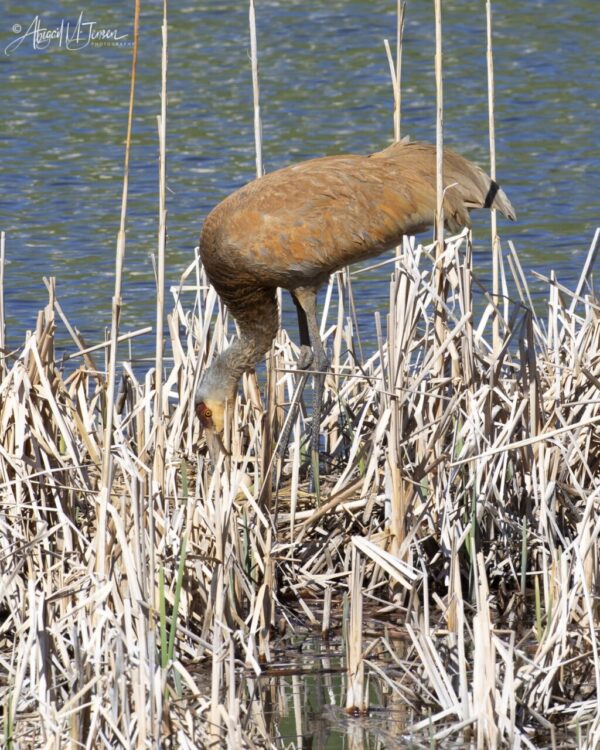
Sandhill Crane Nesting: Frequently Asked Questions
Once sandhill cranes reach four or five years old, they will attempt to breed every year. Almost all cranes are paired and will breed by age eight. Many first-time breeders, due to lack of experience, fail to produce young that survive to independence.
Sandhill cranes are monomorphic, meaning the male and female look the same. However, the unison call (the call made by both cranes together) can help distinguish between the male and female. When calling, the male will point his neck and bill straight up to the sky and will call singularly while the female responds with two notes and points the bill more horizontally.

The male is on the left and female on the right in this photo of a pair calling.
Photo by Patti Mosbey
Generally, cranes mate for life; rarely divorce is known to occur. Pairs that are unsuccessful in producing young may divorce. A pair will often return to the same nesting area each spring. When they arrive, the young from the previous year who have migrated north with their parents are driven off while the pair begins a new family.
In the wild, cranes usually do not mate before they reach the age of four or five. Prior to that time, juvenile cranes form “bachelor flocks” which often occupy the general habitat in which they were raised and travel and feed together until they are ready to breed and set up a territory.
Breeding pairs will establish their territory 2-4 weeks prior to building a nest. In Colorado, sandhill cranes typically start building their nests in mid-April through mid-May. Cranes nesting in Colorado’s higher elevations (7,500 to 9,000 feet) often nest a month later than cranes nesting along the Yampa River Valley. This is due to heavier snow accumulations at higher elevations.
Sandhill cranes will return to the same general area every year to nest, that is, cranes have high nest site fidelity. And they typically build a nest in the same or similar spot. The female typically chooses the nest area however it’s not known who chooses the specific nest site. Sandhill cranes typically nest over standing water in an area with emergent vegetation.

Nesting habitat in Northwest Colorado
Nests are simple, mound-like platforms made of marsh plants, grasses, and weeds piled on the ground in marshes or wet meadows. Larger material forms the foundation of the nest while smaller stems or twigs form and line the egg cup. Both parents may gather material from the immediate area and toss it over their shoulders to form a mound, and in an area with emergent aquatic vegetation will form a characteristic vegetation-free “pluck-zone” surrounding the nest. The female is generally the one to arrange the materials on the mound to form the nest. Their nests may be four to five feet in diameter. Throughout incubation, the incubating adult may add small amounts of material and continually rearrange the nest.

Sandhill crane nest in a wetland in Colorado.
Cranes usually lay two eggs in late April or early May. The eggs are pale brownish buff to olive with brown markings and average 3.6 inches long by 2.3 inches wide.
Cranes and other birds incubate their eggs by sitting on top of them to keep them warm to maintain embryonic development (meaning, development into a baby bird). Cranes and other birds will rotate their eggs every so often to maintain embryonic development and position the egg when it’s ready to hatch. For cranes, incubation begins once the first egg is laid and continues until the second egg hatches or is abandoned. Incubation takes 28-30 days. The female lays eggs 1 or 2 days apart and starts incubation immediately. Therefore, one egg hatches a day or two before the other.
A brood patch is a bare patch of skin on the belly of a bird that forms on birds who incubate their eggs. This patch generally forms during the nesting season and becomes covered in feathers the rest of the year. For cranes, both parents incubate, so both parents develop a brood patch on each side of the sternum. This bare patch of skin, which has additional vessels to bring warm blood close to the surface of the skin, allows heat to transfer from the parent to the egg more efficiently than through feathers.
Yes! Both parents take turns incubating the eggs. The mother typically incubates at night while the father sleeps alone away from the nest. But both males and females share incubation duties equally during the day. When not incubating, the parents will go off to feed in nearby fields.
Sometimes an egg is infertile and therefore won’t hatch. If an egg doesn’t hatch, the parent may continue to incubate it for 10-15 days beyond when the egg should have hatched.
Cranes trade turns incubating about every 2 hours during daylight hours, sharing incubation duties equally during the day. At night the female is usually the one that incubates, thereby performing about 70% of the total incubation. At night, the male will roost away from the nest and return to the nest early in the morning to relieve the female. Older parents are more attentive of their nests and rarely leave their nests unattended, however, younger parents may leave their nests unattended.

Adult Sandhill Crane turning an egg in the nest.
Photo by Abby Jensen
There is some evidence that sandhill cranes can continue incubating a nest on their own and care for the chicks on their own. However, how long a single crane can incubate on his/her own is unknown.
Cranes may abandon their nest if their mate dies, due to human disturbance, or impacts due to predation.
The success of a sandhill crane nest can be affected by numerous things, including: weather (both ambient temperature and precipitation), number and type of predators, water depth surrounding the nest, height and type of vegetation surrounding the nest, density of other sandhill crane pairs nearby, and the devotion of both crane parents. The presence of standing water with emergent vegetation is an important characteristic of crane nesting sites. Deeper water surrounding the nest has been linked to higher nest success, and is thought to protect and isolate the nest against mammalian predators.
Mammalian predators such as racoons, skunks, foxes, and coyotes can eat eggs and chicks. Avian predators that can eat crane eggs and chicks include northern harriers, eagles, common ravens, American crows, great horned owls, and red-tailed hawks. To minimize predation on eggs during incubation, the non-incubating adult may be more secretive than usual, even if not near the nest. When disturbed, breeding cranes often crouch and hide among tall vegetation rather than walking or flying away. Sometimes cranes will use the “broken wing ruse” to lure predators away from the nest or chicks hiding on the ground. The adults will lure predators away by attracting them closer to themselves and then flying away at the last instant. They will also aggressively defend with their wings, beaks, and sharp bills, usually up to a point when threatened by a predator and then fly away.

Broken wing ruse.
Photo by Tom Litteral
Cranes may try to renest following the failure of a first nest. Renesting depends on how far into incubation the nest failed and how far into the breeding season it is. For Greater Sandhill Cranes, only pairs that lost their nests during the first half of incubation have been known to renest.
Parent cranes who are incubating the nest will give “purrs” (a type of sound) up to 3 days before hatching in response to the young vocalizing inside the egg. These sounds may help stimulate hatching. Hatching begins with the young inside the egg breaking the egg from the inside, known as “pipping”. Chick calls from the first egg that’s laid and hatches are thought to stimulate the second egg’s hatching. Within 20 hours of pipping, the chick begins to break the shell and will emerge from the egg about 26 hours later. Parents may help break the egg shell if hatching is prolonged. After hatching, the parents will carry the eggshells and membranes away from the nest.
Sandhill cranes chicks are precocial, meaning they are born in an advanced state compared to other birds such as songbirds. Within 2-3 hours after hatching, their yellow-brown down feathers are dry and their eyes are open. Young chicks can leave the nest by walking or swimming within 8 hours after hatching, but more often leave the nest within 24 hours after hatching. Sandhill crane chicks weigh on average 0.25 lbs (114 grams), a little lighter than an apple. When sandhill crane chicks are born, they are only partially able to regulate their body temperature, and usually wriggle under the adults’ wings and other body feathers for warmth and protection. Chicks begin feeding within 24 hours after hatching. Young chicks will follow their parents and be fed by them, pecking food from their parent’s beaks. Once the chicks are older, they can feed themselves, but the parents may still present new food items to their chicks. If there are two chicks, often they will separate with each going with one adult. This helps reduce competition for food.
1st month – chicks sleep under their mother’s wings for three to four weeks. During the day they run, flap their wings and eat food presented by their parents.
2nd month – chicks become colts, learn to dance and begin pre-flight training.
3rd month – colts learn to forage on their own, dance, practice take-off and landing skills and fly with their parents.
At summer’s end, the colts are ready to migrate south with their parents.
Newly hatched Sandhill Crane chick in nest
Sandhill Crane chicks
Archibald, G. W. and D. L. Viess. 1979. Captive propagation at the International Crane Foundation 1973-1978. Pages 51-74 in J. C. Lewis, editor. Proc. 1978 International Crane Workshop, National Audubon Society, New York, USA.
Drewien, R. C. 1973. Ecology of Rocky Mountain greater sandhill cranes. Dissertation, University of Idaho, Moscow, USA.
Gerber, B. D., J. F. Dwyer, S. A. Nesbitt, R. C. Drewien, C. D. Littlefield, T. C. Tacha, and P. A. Vohs. 2020. Sandhill Crane (Antigone canadensis), in A. F. Poole, editor. Birds of the World. Version 1.0. Cornell Lab of Ornithology, Ithaca, NY, USA.
Hartman, L., S. D. and G. A. Archibald. 1987. The hatching process in cranes with recommendations for assisting abnormal chicks. In Proc. 1985 International Crane Workshop., edited by J. C. Lewis, 387-397. Grand Island, NE: Dist. by U.S. Fish and Wildlife Service.
Howard, T. J. 1977. Ecology of the greater sandhill crane in central Wisconsin. Thesis. University of Wisconsin, Steven’s Point, Wisconsin, USA.
Ivey, G. L., and B. D. Dugger. 2008. Factors influencing nest success of greater sandhill cranes at Malheur National Wildlife Refuge, Oregon. Waterbirds 31:52–61.
Littlefield, C. D. 1995. Female greater sandhill crane continues to incubate after the loss of her mate. Journal of Field Ornithology 66:296–298.
Marasco, V., and K. A. Spencer. 2015. Improvements in our understanding of behaviour during incubation. Pages 142–151 in D. C. Deeming and S. J. Reynolds, editors. Nests, Eggs, and Incubation. Oxford University Press, United Kingdom.
McWethy, D. B., and J. E. Austin. 2009. Nesting ecology of Greater Sandhill Cranes (Grus canadensis tabida) in riparian and palustrine wetlands of eastern Idaho. Waterbirds 32:106–115.
Skutch, A. F. 1957. The incubation patterns of birds. Ibis 99(1):69-93.
Tacha, T. C. 1988. Social organization of Sandhill Cranes from mid-continental North America. Wildlife Monographs 99.
Walkinshaw, L. H. 1973. Cranes of the world. Winchester Press, New York, USA




